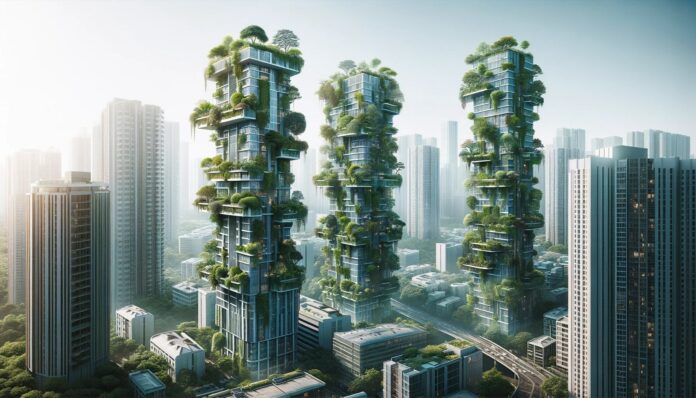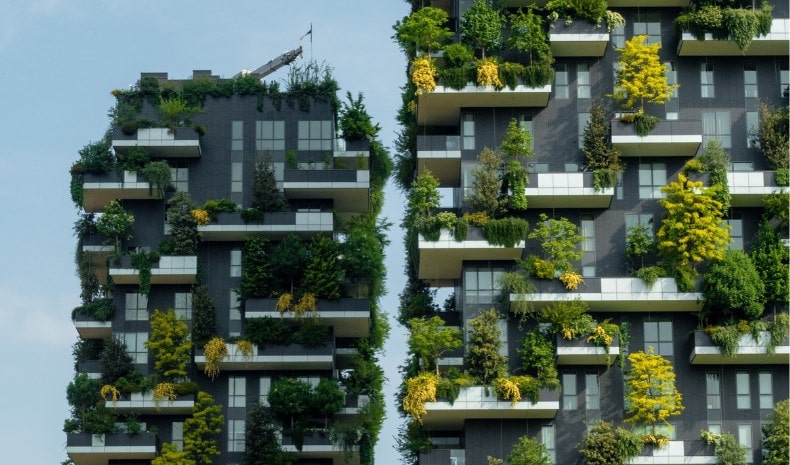
Can a building help fight air pollution? Imagine an urban environment where skyscrapers are not just concrete and steel, but thriving ecosystems that support urban biodiversity and urban forestry. Welcome to the world of vertical forests – innovative architectural solutions that combine skyscrapers and gardens to combat air pollution in urban areas. These green towers feature balconies filled with lush vegetation, creating a harmonious blend of nature and urban life. Italy has embraced the concept of vertical forest, pioneering the integration of traditional forests and shrubs into its cityscapes as a means to improve urban air quality. Forest towers have been implemented to achieve this goal.
Vertical forests offer a unique approach to tackling the pressing issue of air pollution in the urban environment. These innovative structures not only contribute to urban forestry and urban biodiversity but also provide a solution that urban planners can consider. These urban forestry projects, such as the vertical forest, are innovative green structures that blend nature and architecture. They aim to create healthier environments for humans and the planet, offering an alternative to traditional forests. These projects are a step towards creating a forest city. By harnessing the power of plants, vertical forests in space absorb carbon dioxide and release oxygen, acting as natural air purifiers. Vertical forests and forest cities also provide habitat for birds and insects while enhancing biodiversity in densely populated cities, creating green space in urban areas.
Join us as we uncover how these architectural innovations in the space industry are revolutionizing our fight against air pollution, specifically through the implementation of vertical forests.
Italian Architect’s Innovative Solution: Creating Vertical Forests
Italian architects have taken a groundbreaking approach to combat air pollution in urban areas by introducing the concept of vertical forests in space. Their innovative solution involves integrating trees and vegetation into high-rise buildings, creating a vertical forest and bringing nature back into the concrete jungles through sustainable design.
By incorporating vertical forests into the architecture, these visionary architects are revolutionizing the way cities are built with greenery. Instead of traditional buildings with plain facades and barren rooftops, they are transforming them into vertical forests, which are living ecosystems that provide numerous benefits for both humans and the environment.
Bringing Nature to New Heights
Vertical forests consist of tall structures adorned with balconies, terraces, and facades covered in lush vegetation. Each vertical forest tree is strategically planted to maximize its impact on air quality while minimizing space requirements. These vertical forests not only serve as stunning visual landmarks but also act as natural air purifiers. These towering green structures are designed to bring nature into urban areas, providing a breath of fresh air for city dwellers.
A Breath of Fresh Air
One of the key advantages of vertical forests is their ability to combat air pollution effectively. Vertical forests, consisting of trees, play a vital role in absorbing carbon dioxide and releasing oxygen through photosynthesis. By integrating trees into high-rise buildings, these vertical forests help offset carbon emissions from surrounding areas.
The presence of trees in a vertical forest also helps filter harmful pollutants from the air, such as particulate matter and volatile organic compounds (VOCs). This contributes to cleaner air quality within urban environments, making it healthier for residents and reducing respiratory issues caused by pollution. Additionally, the presence of a vertical forest enhances the overall aesthetic appeal and biodiversity of the area.
Sustainable Design for a Greener Future
Vertical forests represent a paradigm shift in architectural design by prioritizing sustainability and biodiversity. These innovative vertical forests promote ecological balance by providing habitats for birds, insects, and other wildlife that may have been displaced due to urbanization.
Moreover, vertical forests contribute to energy efficiency by acting as natural insulators. The vertical forest foliage helps regulate temperatures within buildings, reducing the need for excessive heating or cooling systems. The presence of the vertical forest creates a natural cooling effect, reducing the reliance on artificial cooling methods. Additionally, the vertical forest acts as a natural insulator, helping to keep buildings warm during colder seasons. Overall, the implementation of a vertical forest can significantly contribute to energy efficiency and sustainability in building design. This not only decreases energy consumption but also lowers greenhouse gas emissions associated with traditional building practices, making it an environmentally friendly option. The concept of a vertical forest has gained popularity in recent years due to its innovative approach to sustainable architecture.
A Win-Win for Developers and Communities
Developers are increasingly recognizing the value of incorporating vertical forests into their projects. These vertical forest green buildings have become highly sought after due to their aesthetic appeal and environmental benefits. The presence of vertical forests can significantly increase property values, attracting potential buyers or tenants who prioritize sustainability and a connection with nature.
Communities also benefit from the introduction of vertical forests. These vertical forests provide opportunities for relaxation, recreation, and social interaction within urban environments. Residents can enjoy the beauty of nature and promote well-being and mental health by living in a vertical forest within the city.
High-rise Forests in Italy: Fighting Air Pollution and Improving Urban Air Quality

High-rise forests in Italy play a crucial role in combating air pollution. These vertical forest architectural structures are designed to tackle the challenges posed by air pollution in urban areas. By incorporating nature into the heart of cities, these vertical forests provide a sustainable solution to improve urban air quality.
These vertical forest structures help filter harmful pollutants from the surrounding atmosphere, ensuring cleaner and healthier air. The presence of trees and vegetation on high-rise buildings acts as a natural filter, trapping particulate matter and absorbing carbon dioxide. This is why vertical forests are becoming increasingly popular in urban areas. As a result, the air inside and around these buildings becomes cleaner and healthier for residents.
Improving urban air quality is of paramount importance as it directly impacts the well-being of city dwellers. Poor air quality can have detrimental effects on human health, leading to respiratory problems, cardiovascular diseases, and even premature death. Vertical forests offer an effective way to mitigate these risks by providing cleaner air for people living in densely populated areas.
The benefits of high-rise forests extend beyond just cleaner air; they contribute to creating a healthier living environment overall. The presence of green spaces within cities has been proven to enhance mental well-being and reduce stress levels among residents. Being surrounded by nature helps create a sense of calmness amidst the hustle and bustle of urban life.
In addition to combating air pollution, vertical forests also address other environmental challenges such as climate change. Trees absorb carbon dioxide through photosynthesis, making them valuable allies in reducing greenhouse gas emissions. By integrating nature into architectural designs, these vertical forests contribute to mitigating climate change effects while providing numerous co-benefits.
The concept of high-rise forests presents an innovative solution that maximizes limited space in urban areas while harnessing the power of nature. It demonstrates how architecture can be used not only for functional purposes but also as a means to create sustainable environments that prioritize human health and well-being.
While implementing high-rise forests may pose challenges, such as the need for careful planning and maintenance, the long-term benefits outweigh these obstacles. The positive impact on air quality, mental well-being, and climate change mitigation make vertical forests a worthwhile investment for cities worldwide.
The Energy-saving Potential of Vertical Forests
Vertical forests are not only aesthetically pleasing architectural innovations but also hold significant energy-saving potential. These green structures combat air pollution and contribute to the reduction of carbon emissions, making our cities more sustainable and eco-friendly.
Natural Cooling Effect
One of the key reasons why vertical forests have such a remarkable energy-saving potential is their natural cooling effect. The trees and plants within these structures provide shade, which helps reduce the need for artificial cooling systems. By blocking direct sunlight and absorbing heat, they create a cooler microclimate in their surroundings.
Reducing the Need for Artificial Cooling Systems
The shade provided by vertical forests helps decrease the reliance on energy-intensive air conditioning units in urban areas. Traditional forests have long been known to cool down their immediate environment through evapotranspiration, where plants release water vapor into the air. Vertical forests replicate this process on a larger scale within an urban setting.
By reducing the need for artificial cooling systems, vertical forests contribute to significant energy savings. This not only leads to lower electricity consumption but also decreases carbon emissions associated with power generation. As a result, these innovative structures play a crucial role in mitigating climate change impacts.
Creating Sustainable and Eco-friendly Cities
Harnessing the energy-saving potential of vertical forests can pave the way for more sustainable and eco-friendly cities. By incorporating green spaces vertically rather than horizontally, we maximize land use efficiency while still reaping all the benefits that traditional forests offer.
Vertical forests act as natural air filters by capturing pollutants from the atmosphere through their leaves and branches. They help improve urban air quality by reducing harmful particulate matter and absorbing carbon dioxide—a major greenhouse gas responsible for global warming.
Moreover, these green structures enhance biodiversity within urban environments by providing habitats for various species of birds, insects, and other wildlife. They create pockets of nature amidst concrete jungles, fostering ecological balance within our cities.
In addition to their environmental benefits, vertical forests also have a positive impact on human well-being. Research has shown that exposure to green spaces can reduce stress levels, improve mental health, and enhance overall quality of life. By integrating nature into our urban landscapes, we create healthier and more livable cities for everyone.
Transforming Urban Landscapes: How Vertical Forests Improve City Life
Vertical forests are architectural innovations that are transforming urban landscapes by incorporating green spaces within concrete jungles. These forest towers, also known as vertical forests or forest cities, are revolutionizing the way we perceive and experience cities.
Enhancing Aesthetics: Making Cities Visually Appealing
One of the remarkable aspects of vertical forests is their ability to enhance the visual appeal of cities. These towering structures covered in lush greenery create a striking contrast against the backdrop of concrete buildings. The vibrant colors and textures provided by these living walls breathe life into urban environments, making them more visually captivating for both residents and visitors.
Green Oases for Recreation and Relaxation
Vertical forests offer more than just visual beauty; they provide valuable spaces for recreation and relaxation amidst busy city life. These green oases serve as havens where people can escape from the hustle and bustle of daily routines. Residents can enjoy strolling through tree-lined paths, meditating in tranquil gardens, or simply sitting on a bench surrounded by nature’s serenity.
Improved Mental Well-being
The presence of vertical forests has a profound impact on mental well-being in urban areas. Numerous studies have shown that exposure to nature reduces stress levels, improves mood, and enhances cognitive function. Vertical forests act as natural air filters, absorbing pollutants while releasing oxygen into the atmosphere. This cleaner air promotes better respiratory health and contributes to an overall sense of well-being among city dwellers.
Contributing to Livability
By improving city life through their aesthetic appeal and positive effects on mental well-being, vertical forests significantly contribute to the overall livability of urban areas. These architectural marvels create a harmonious balance between human-made structures and nature’s beauty. They provide a sense of connection to the natural world, even in the midst of towering skyscrapers and bustling streets.
Vertical forests also play a crucial role in urban biodiversity conservation. By creating habitats for various plant and animal species, they promote ecological balance within cities. These green spaces attract birds, bees, butterflies, and other pollinators, enhancing urban ecosystems and supporting biodiversity.
Leveraging Green Architecture: Benefits of Vertical Forests in Combating Air Pollution
Green architecture, exemplified by vertical forests, offers numerous benefits in combating air pollution. These innovative structures not only enhance the aesthetic appeal of urban areas but also play a crucial role in improving air quality and mitigating the harmful effects of pollution. Let’s explore how vertical forests can effectively address the challenges posed by air pollution.
Vegetation Absorbs Carbon Dioxide and Releases Oxygen
One of the key advantages of vertical forests is their ability to absorb carbon dioxide and release oxygen through photosynthesis. The dense vegetation within these structures acts as a natural carbon sink, helping to reduce greenhouse gas emissions and combat climate change. By removing carbon dioxide from the atmosphere, vertical forests contribute to cleaner air and a healthier environment for urban dwellers.
Natural Air Filters that Reduce Pollution Levels
Vertical forests act as effective natural air filters, trapping particulate matter and reducing pollution levels in urban areas. The leaves and branches of trees help to capture airborne pollutants such as dust, smoke, and harmful chemicals. In addition to filtering out pollutants, vertical forests also provide shade, reducing heat island effect in cities and improving overall air quality.
Enhancing Biodiversity in Urban Spaces
Another significant benefit of vertical forests is their ability to enhance biodiversity within urban spaces. By creating habitats for various plant species and attracting birds, insects, and other wildlife, these green structures promote ecological balance in densely populated areas. Increased biodiversity not only contributes to a healthier ecosystem but also provides opportunities for educational programs and research on urban ecology.
Improving Mental Health and Well-being
Vertical forests have been shown to have positive impacts on mental health and well-being. The presence of green spaces has been linked to reduced stress levels, improved mood, increased productivity, and enhanced overall quality of life. As vertical forests bring nature closer to people’s daily lives in urban environments, they offer an escape from the concrete jungle, providing a sense of tranquility and connection with the natural world.
Encouraging Sustainable Development and Urban Planning
The implementation of vertical forests encourages sustainable development and urban planning practices. By incorporating green spaces into architectural designs, cities can create more sustainable and livable environments for their residents. Vertical forests serve as examples of how innovative design solutions can be integrated into urban landscapes to address pressing environmental issues such as air pollution.
Sustainable Urban Planning: Integrating Vertical Forests for a Greener Future
Incorporating vertical forests into sustainable urban planning is a powerful step towards creating a greener future. Not only do these innovative structures combat air pollution, but they also offer numerous other benefits that contribute to biodiversity conservation and the overall well-being of urban areas.
Promoting Biodiversity Conservation
Vertical forests are more than just architectural marvels; they serve as thriving ecosystems within urban environments. By integrating various plant species into their design, these structures provide habitats for birds, insects, and other wildlife. This promotes biodiversity conservation by offering refuge to species that may otherwise struggle to find suitable homes in densely populated cities.
Mitigating the Heat Island Effect
Urban areas often suffer from the heat island effect, where concrete and asphalt absorb and radiate heat, leading to higher temperatures compared to surrounding rural areas. However, vertical forests act as natural coolants by providing shade and evaporative cooling through transpiration. The dense vegetation helps reduce ambient temperatures, creating a more pleasant microclimate within the city.
Reducing Energy Consumption
Vertical forests have another significant advantage – they help lower energy consumption in cities. The foliage of these structures acts as a natural barrier against direct sunlight, reducing the need for excessive air conditioning during hot summers. The plants absorb carbon dioxide and release oxygen through photosynthesis, improving air quality and reducing the reliance on mechanical ventilation systems.
Creating Sustainable and Resilient Urban Spaces
By incorporating vertical forests into urban planning strategies, cities can build a more sustainable and resilient environment for their residents. These green spaces not only enhance aesthetics but also improve mental well-being by providing opportunities for relaxation and recreation amidst nature. They act as valuable social spaces where people can connect with nature while enjoying the benefits of living in an urban setting.
Inspiring Future Architectural Innovations
The integration of vertical forests into urban planning paves the way for a new generation of sustainable architectural projects. As urban planners and architects witness the positive impact of these structures, they are inspired to incorporate more green elements into their designs. This creates a ripple effect, leading to the development of innovative solutions that address environmental challenges while providing functional and aesthetically pleasing spaces for humans.
Harnessing the Potential of Vertical Forests to Combat Air Pollution
Congratulations on completing the sections exploring the incredible potential of vertical forests in combating air pollution! By harnessing architectural innovations, these high-rise forests have proven to be a game-changer in improving urban air quality and transforming our cities into greener, healthier spaces.
Now that you understand the energy-saving potential and numerous benefits of vertical forests, it’s time to take action. Consider advocating for the integration of green architecture and sustainable urban planning in your own community. Encourage local authorities, architects, and developers to embrace these innovative solutions for a better future.
Remember, every small step counts. Whether it’s planting trees in your backyard or supporting initiatives that promote green spaces in urban areas, you can contribute to combating air pollution and creating a more sustainable world. Together, we can build a future where nature and architecture coexist harmoniously, revitalizing our cities while protecting our planet.
FAQs
How do vertical forests combat air pollution?
Vertical forests combat air pollution by absorbing carbon dioxide (CO2) and releasing oxygen through photosynthesis. The abundance of trees in these high-rise structures acts as natural filters, trapping harmful pollutants such as particulate matter (PM), nitrogen dioxide (NO2), and volatile organic compounds (VOCs).
Can vertical forests really improve urban air quality?
Yes! Vertical forests have been shown to significantly improve urban air quality by reducing pollutant levels. Studies have demonstrated that these green structures effectively filter out airborne toxins, resulting in cleaner air for city dwellers.
Do vertical forests provide any other benefits besides combating air pollution?
Absolutely! Vertical forests offer a range of additional benefits beyond combating air pollution. They enhance biodiversity by providing habitats for birds and insects, reduce energy consumption by regulating temperature extremes within buildings, mitigate noise pollution, and contribute to overall mental well-being by creating visually appealing green spaces within densely populated areas.
Are there any limitations or challenges associated with vertical forests?
While the concept of vertical forests is promising, there are some challenges to consider. These include the initial high costs of construction and maintenance, limited availability of suitable land for implementation, and potential difficulties in ensuring proper irrigation and care for the trees at higher heights.
How can I support the development of vertical forests in my area?
To support the development of vertical forests in your area, you can start by raising awareness about their benefits among local communities and decision-makers. Engage with environmental organizations, participate in tree-planting initiatives, and advocate for sustainable urban planning policies that prioritize green architecture. Consider supporting projects financially or volunteering your time to help establish and maintain these innovative green spaces.


